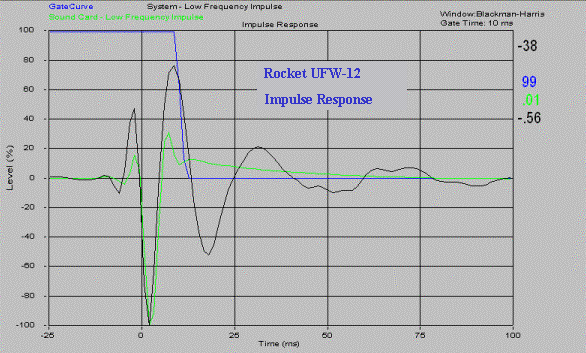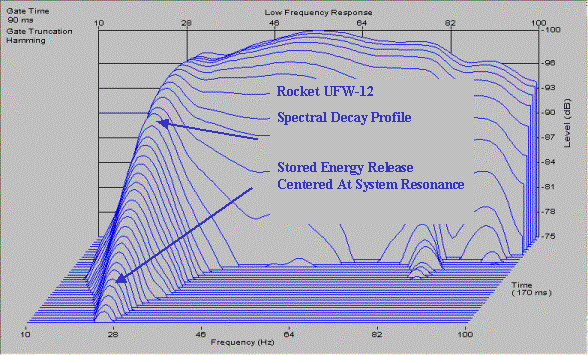Group Delay Calculation: A sufficiently large and abrupt phase shift may
cause the perception of time smearing at the affected frequencies. Group
Delay (GD) is used to quantify this phenomenon, and is essentially the derivative
of phase with respect to frequency. Extrapolations of existing GD studies
suggest an audibility threshold of 1.0 to 1.5 cycles.
The UFW-12 holds group delay below 1 cycle down to about 31 Hz, where it
then quickly rises and eventually exceeds 1.5 cycles at 22 Hz. This GD
behavior results from the steep high pass filter used to help protect the
woofer from over-excursion.
Since the UFW-12 holds GD below 1 cycle across most of the bass music
spectrum, enthusiasts can expect "on-time" sound delivery from this
subwoofer with popular (e.g., rock/pop/jazz) music, which usually doesn't
contain much bass below 30 Hz.

System Ringing and Stored Energy Release Test: The amount of system ringing
and stored energy release exhibited by a subwoofer is a function of its
acoustic alignment and roll-off profile. A subwoofer with a narrow F6
bandwidth and a steep roll-off will ring longer and release more stored
energy than will a subwoofer with a wider F6 bandwidth and a shallower
roll-off profile.
Most subwoofers will ring anywhere from 25-200 ms at system resonance.
Similar to group delay, the audibility of system ringing and stored energy
release is frequency-dependent. The deeper it occurs, the less likely it
will be noticeable on music and movies.
The UFW-12 exhibits a system Q of about 1.0 and a roll-off slope of 84
dB/octave below 23 Hz. This combination results in a narrow F6 bandwidth and
system ringing for about 170 ms, as shown on the impulse response chart
below. As
illustrated in the spectral decay chart below, this ringing is centered at/near 27
Hz, which is the system resonance frequency.
Since the majority of this ringing occurs below 30 Hz, listeners can expect
minimal overhang and tight sound with popular music (again which contains
little content below 30 Hz). Also, readers should be reminded that the
listening room itself has a very large influence on perceived tightness, and
that excessive overhang is often the result of room modes and can usually be
remedied with room treatments and bass traps.



Click Here to Go to Part VI.